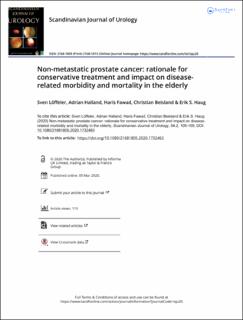Non-metastatic prostate cancer: rationale for conservative treatment and impact on disease-related morbidity and mortality in the elderly
Journal article, Peer reviewed
Published version

Åpne
Permanent lenke
https://hdl.handle.net/11250/2729738Utgivelsesdato
2020Metadata
Vis full innførselSamlinger
- Department of Clinical Medicine [2066]
- Registrations from Cristin [9791]
Originalversjon
Scandinavian Journal of Urology. 2020, 54 (2) , 105–109 10.1080/21681805.2020.1732463Sammendrag
Purpose: To determine the rationale for not offering local treatment to prostate cancer patients with non-metastatic disease at diagnosis who later died of prostate cancer and to document local and systemic complications caused by disease progression.
Material and Methods: In this population-based, retrospective study we reviewed the medical records of all patients who died of prostate cancer in 2009–2014 in Vestfold County (Vestfold Mortality Study), who were non-metastatic at diagnosis and who had received no local treatment to the prostate (n = 117).
Results: A review of patient records demonstrated that the chronological age of 75 years or older was the main rationale for not offering local treatment to the prostate (37%, n = 43). No consideration was given to the functional status and patient health. These elderly patients stood for almost one-fifth of the total PC mortality in Vestfold County. In addition to dying from PC, 86% of patients developed local complications attributable to PC progression. Observation of strict limits for local treatment with regard to tumor characteristics contributed further to the underuse of local treatment.
Conclusions: Our study demonstrated systematic undertreatment of elderly patients with aggressive, non-metastatic PC with regard to local treatment based on chronological age alone. The patients in this study died of prostate cancer and the majority experienced significant morbidity caused by local tumor growth.
